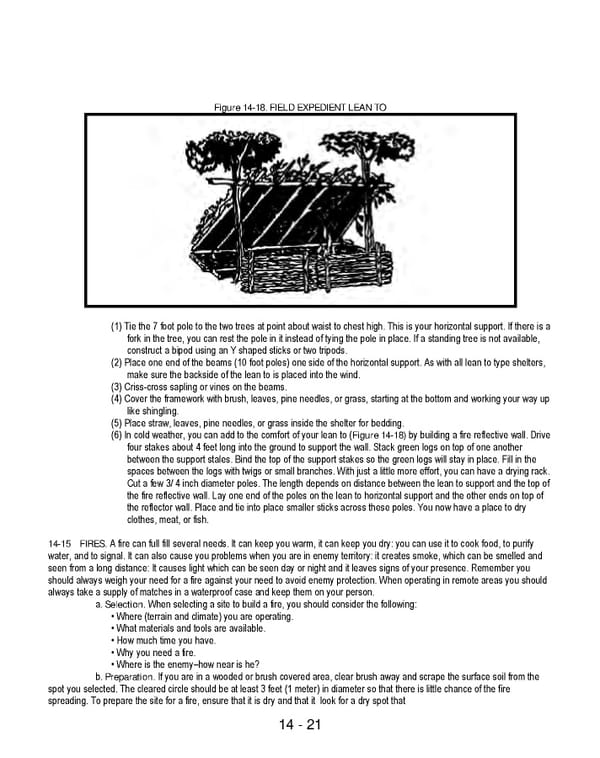14 - 21 Figure 14-18. FIELD EXPEDIENT LEAN TO (1) Tie the 7 foot pole to the two trees at point about waist to chest high. This is your horizontal support. If there is a fork in the tree, you can rest the pole in it instead of tying the pole in place. If a standing tree is not available, construct a bipod using an Y shaped sticks or two tripods. (2) Place one end of the beams (10 foot poles) one side of the horizontal support. As with all lean to type shelters, make sure the backside of the lean to is placed into the wind. (3) Criss-cross sapling or vines on the beams. (4) Cover the framework with brush, leaves, pine needles, or grass, starting at the bottom and working your way up like shingling. (5) Place straw, leaves, pine needles, or grass inside the shelter for bedding. (6) In cold weather, you can add to the comfort of your lean to (Figure 14-18) by building a fire reflective wall. Drive four stakes about 4 feet long into the ground to support the wall. Stack green logs on top of one another between the support stales. Bind the top of the support stakes so the green logs will stay in place. Fill in the spaces between the logs with twigs or small branches. With just a little more effort, you can have a drying rack. Cut a few 3/ 4 inch diameter poles. The length depends on distance between the lean to support and the top of the fire reflective wall. Lay one end of the poles on the lean to horizontal support and the other ends on top of the reflector wall. Place and tie into place smaller sticks across these poles. You now have a place to dry clothes, meat, or fish. 14-15 FIRES. A fire can full fill several needs. It can keep you warm, it can keep you dry: you can use it to cook food, to purify water, and to signal. It can also cause you problems when you are in enemy territory: it creates smoke, which can be smelled and seen from a long distance: It causes light which can be seen day or night and it leaves signs of your presence. Remember you should always weigh your need for a fire against your need to avoid enemy protection. When operating in remote areas you should always take a supply of matches in a waterproof case and keep them on your person. a. Selection. When selecting a site to build a fire, you should consider the following: • Where (terrain and climate) you are operating. • What materials and tools are available. • How much time you have. • Why you need a fire. • Where is the enemy–how near is he? b. Preparation. If you are in a wooded or brush covered area, clear brush away and scrape the surface soil from the spot you selected. The cleared circle should be at least 3 feet (1 meter) in diameter so that there is little chance of the fire spreading. To prepare the site for a fire, ensure that it is dry and that it look for a dry spot that
 Ranger Handbook Page 268 Page 270
Ranger Handbook Page 268 Page 270